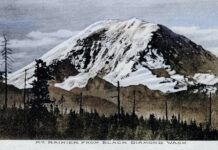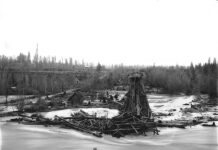The most productive coal mines in Washington were those located in Roslyn, now home to a posh housing development and resort called Suncadia. It has three golf courses and 2,000 homes. Back in the 1950s, when this photo was taken, Roslyn and nearby Cle Elum were still gritty coal mining towns populated by men carrying lunch buckets and descending underground in rotating shifts. Shown here is a coal miner in Roslyn No. 9 operating a hydraulic mining monitor. A pressurized jet of water from a nozzle with 3,000 pounds per square inch sliced through coal like a knife. This form of hydraulic mining cut the lower portion of the seam allowing the upper parts to collapse from their own weight. The loose coal was then loaded into awaiting mine cars. Hydraulic mining was sometimes used, but the more common mining method was mechanical cutting machines.
The Roslyn mines opened in 1885 with first shipments made in November 1886. Within two years the town supported Washington territory’s largest coal mines, with annual production far exceeding any other district. Immigrant miners flocked to the area, evidenced today by 25 cemeteries each for distinct ethnic groups. The mines were operated by the Northwest Improvement Company (NWI), a subsidiary of Northern Pacific Railroad which used coal to fuel their locomotives. With the introduction of diesel engines, coal production declined and the Roslyn mines limped through the 1950s with the aid of government contracts. By 1957, NWI was dissolved and supplanted by the Northern Pacific Railway Coal Department. The last Roslyn mine closed in 1963, but during their 77-year history the Kittitas County coal fields produced over 50 million tons, more than a third of Washington State’s production to that date. This image comes courtesy of the Washington State Digital Archives, Item # AR-280010001-ph000431.






